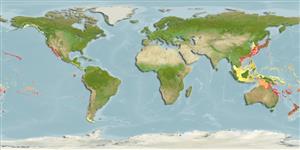Environment: milieu / climate zone / depth range / distribution range
Ecología
marino bentopelágico; oceanodromo (Ref. 51243); rango de profundidad 0 - 100 m (Ref. 58302). Temperate
Pacific: Japan (Ref. 559) and South Korea (Ref. 77001). Eastern Pacific: rare off California, USA.
Tamaño / Peso / Age
Maturity: Lm ? range ? - ? cm
Max length : 61.0 cm TL macho / no sexado; (Ref. 2850)
Espinas dorsales (total): 0; Radios blandos dorsales (total): 46-55; Espinas anales 0; Radios blandos anales: 40 - 43. Dorsal and anal fins very high. Dorsal fin inserted above middle of snout, the fin reaching a little behind the caudal fin base, the 4th ray much stouter than others. Dorsal and anal fins with scaly sheaths; rays of the fins not articulated. Attains 45 cm SL.
Oceanic. The species is very rare and most likely seen as stomach content of large predatory fishes, such as tunas. Young probably inhabits shallow, adult deep water.
Life cycle and mating behavior
Madurez | Reproducción | Puesta | Huevos | Fecundidad | Larva
Eschmeyer, W.N., E.S. Herald and H. Hammann, 1983. A field guide to Pacific coast fishes of North America. Boston (MA, USA): Houghton Mifflin Company. xii+336 p. (Ref. 2850)
IUCN Red List Status (Ref. 130435)
Threat to humans
Harmless
Human uses
Más información
Nombres comunesSinónimosMetabolismoDespredadoresEcotoxicologíaReproducciónMadurezPuestaAgregación para la puestaFecundidadHuevosEgg development
ReferenciasAcuiculturaPerfil de acuiculturaRazasGenéticaElectrophoresesheritabilidadEnfermedadesProcesamientoNutrientsMass conversion
ColaboradoresImágenesStamps, Coins Misc.SonidosCiguateraVelocidadTipo de nataciónSuperficie branquialOtolitosCerebrosVisión
Herramientas
Special reports
Download XML
Fuentes de Internet
Estimates based on models
Preferred temperature (Ref.
123201): 14.8 - 26.3, mean 23.3 °C (based on 390 cells).
Phylogenetic diversity index (Ref.
82804): PD
50 = 0.6250 [Uniqueness, from 0.5 = low to 2.0 = high].
Bayesian length-weight: a=0.00389 (0.00180 - 0.00842), b=3.12 (2.94 - 3.30), in cm total length, based on all LWR estimates for this body shape (Ref.
93245).
Nivel trófico (Ref.
69278): 4.2 ±0.6 se; based on size and trophs of closest relatives
Resiliencia (Ref.
120179): Bajo, población duplicada en un tiempo mínimo de 4.5-14 años (tmax=9-11; very rare).
Fishing Vulnerability (Ref.
59153): Moderate vulnerability (44 of 100).
